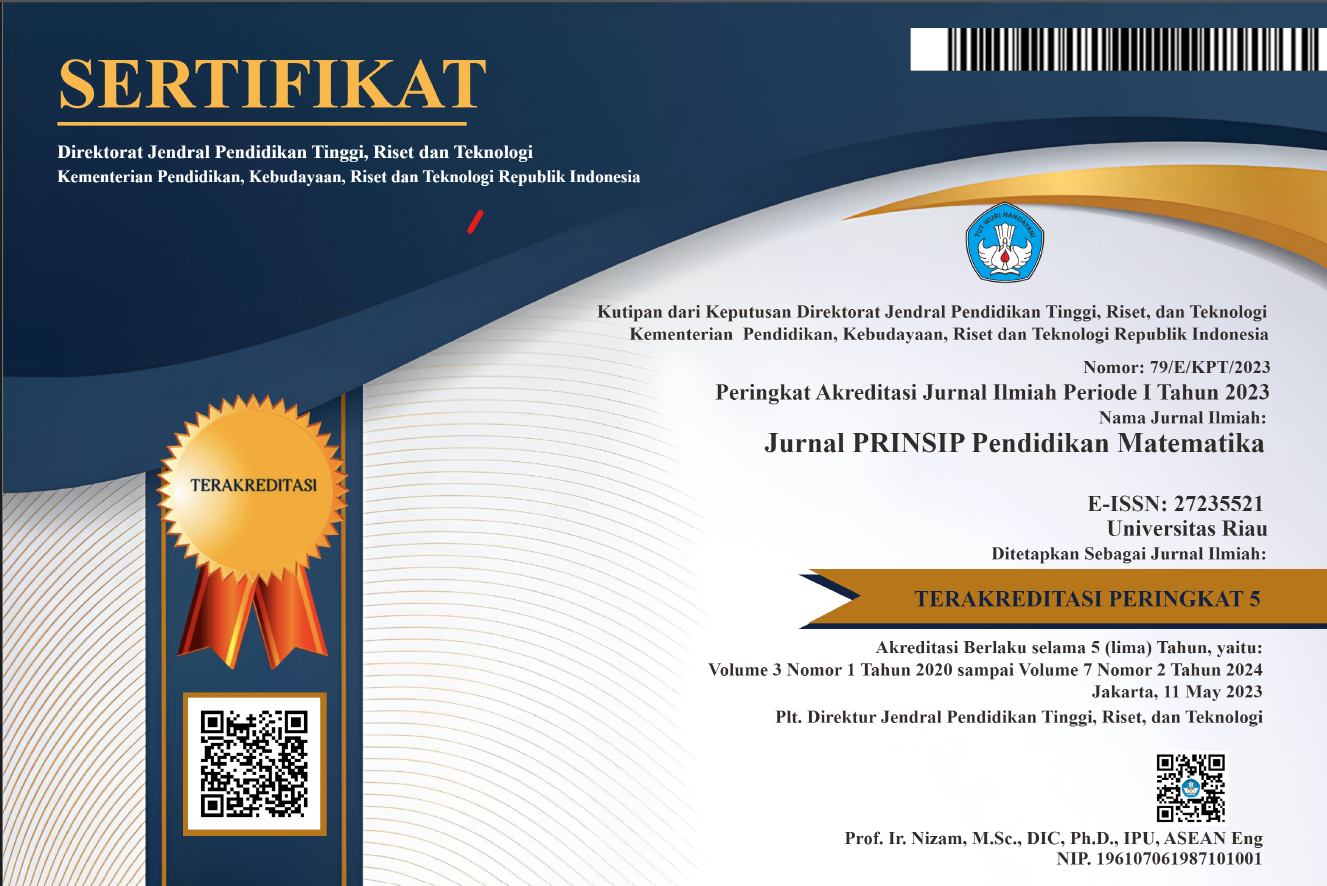THE EFFECTIVENESS OF MATHEMATICS LEARNING USING INSTRUCTIONAL MEDIA FOR EIGHTH-GRADE STUDENTS ON THREE-DIMENSIONAL SHAPES
Abstract
This research was motivated by the low mathematics learning outcomes among students. The objective of this study is to enhance mathematics learning outcomes through the use of Android-based instructional media. The research design employed was classroom action research, aimed at determining the effectiveness of mathematics instruction using the Geometry Adventure learning media among eighth-grade students at SMP Muhammadiyah 22 Setiabudi Pamulang, with a sample size of 32 students. Data were collected using several research instruments, including learning outcome tests, student activity observations, student response questionnaires, and learning implementation assessments. The findings of the study indicate that the use of the Geometry Adventure learning media positively impacts student learning outcomes, enhances student engagement and participation in the learning process, and fosters positive student responses toward mathematics instruction. Furthermore, teachers found it beneficial in managing a more interactive and conducive learning environment, making the learning process more effective and enjoyable. These findings provide a foundation for the development of more innovative technology-based learning media and their application to broader educational contexts and subject matter.
Downloads
References
Alimus, M., Akib, I., & S, A. (2019). Efektivitas Pembelajaran Matematika melalui Penggunaan Media Education Game Maju Mundur Cantik (Cari dan Tebak Instruksi) pada Siswa Kelas VII SMP Unismuh Makassar. SIGMA (Suara Intelektual Gaya Matematika), 11(1), 65–77. https://doi.org/10.26618/sigma.v11i1.3080
Amir, A. (2016). Penggunaan Media Gambar dalam Pembelajaran Matematika. Jurnal Eksakta, 2(1), 34–40. https://doi.org/http://dx.doi.org/10.31604/eksakta.v1i2.%25p
Apsari, P. N., & Rizki, S. (2018). Media Pembelajaran Matematika Berbasis Android pada Materi Program Linear. AKSIOMA : Jurnal Program Studi Pendidikan Matematika, 7(1), 161–170. https://doi.org/http://dx.doi.org/10.24127/ajpm.v7i1.1357
Asmarani, D., Zahroh, U., & Dewanti, S. (2022). Development of GeoGebra-Based Learning Media for Flat Field Analytical Geometry Courses for Students of the Mathematics Education Department. Journal of Research on Mathematics Instruction (JRMI), 4(1), 1–10. https://doi.org/10.33578/jrmi.v4i1.74
Febriyanti, R., & Prasetyo, B. (2020). the Effect of the Implementation of Learning Media Based on Interactive Multimedia on the Learning Outcomes Mathematics of Students in Junior High School. Jurnal Prinsip Pendidikan Matematika, 3(1), 1–8. https://doi.org/10.33578/prinsip.v3i1.65
Handoyo, H. B., & Arif Rahman Hakim. (2016). Pengaruh Penggunaan Alat Peraga Jam Sudut Terhadap Hasil Belajar Matematika. JKMP (Jurnal Kajian Pendidikan Matematika), 1(2), 204–214. https://doi.org/http://dx.doi.org/10.30998/jkpm.v1i2.1188
Hasmawati, H., Usman, U., & Ahsan. (2022). Peningkatan Kemampuan Peserta Didik dalam Menjumlah Bilangan Pecahan dengan Menggunakan Media Gambar Luas Daerah di Kelas VII MTs.N 1 Enrekang. Journal of Mathematics Learning Innovation (Jmli), 1(1), 17–32. https://doi.org/10.35905/jmlipare.v1i1.3259
Komariah, S., Suhendri, H., & Hakim, A. R. (2018). Pengembangan Media Pembelajaran Matematika Siswa SMP Berbasis Android. JKPM (Jurnal Kajian Pendidikan Matematika), 4(1), 43–52. https://doi.org/10.30998/jkpm.v4i1.2805
Maarif, S., Hartiningrum, E. S. N., & Karimah, U. (2023). The Effectiveness of the Cooperative Learning Model Snowball Drilling Type in Mathematics Learning. Jurnal Prinsip Pendidikan Matematika, 6(2), 100–108. https://doi.org/10.33578/prinsip.v6i2.205
Meltzer, D. E. (2002). The Relationship Between Mathematics Preparation and Conceptual Learning Gains in Physics: A Possible “Hidden Variable” in Diagnostic Pretest Scores. American Journal of Physics, 70(12), 1259–1268. https://doi.org/10.1119/1.1514215
Pane, A., & Dasopang, M. D. (2017). Belajar dan Pembelajaran. FITRAH:Jurnal Kajian Ilmu-Ilmu Keislaman, 3(2), 227–352. https://doi.org/10.24952/fitrah.v3i2.945
Rohman, A. (2023). Efektivitas Media Pembelajaran Matematika Berbasis Android Untuk Meningkatkan Minat Belajar Siswa Sekolah Dasar. Papanda Journal of Mathematics and Science Research, 2(2), 72–79. https://doi.org/10.56916/pjmsr.v2i2.507
Saputro, H. B., & Nurrahmi, A. (2023). Differential: Journal on Mathematics Education. Journal on Mathematics Education, 1, 57–67.
Siregar, H. M., Nurjanah, & Nuraeni, R. (2024). Development and Integration of GeoGebra Applets in Mathematics Learning. Pedagonal : Jurnal Ilmiah Pendidikan, 8(1), 33–46. https://doi.org/10.55215/pedagonal.v8i1.9362
Solfitri, T., Siregar, H. M., Kartini, & Permata, A. (2024). Facilitating Mathematical Creative Thinking Ability: Analysis of Validation, Practicality, and Effectiveness of Learning Modules. Jurnal Pendidikan Progresif, 14(1), 619–634. https://doi.org/10.23960/jpp.v14.i1.202445.
Copyright (c) 2024 Jurnal Prinsip Pendidikan Matematika

This work is licensed under a Creative Commons Attribution-NonCommercial-ShareAlike 4.0 International License.





